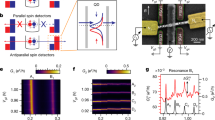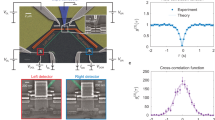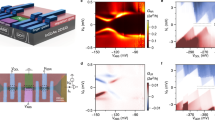Abstract
Non-local entanglement is a key ingredient to quantum information processing. For photons, entanglement has been demonstrated1, but it is more difficult to observe for electrons. One approach is to use a superconductor, where electrons form spin-entangled Cooper pairs, which is a natural source for entangled electrons. For a three-terminal device consisting of a superconductor sandwiched between two normal metals, it has been predicted that Cooper pairs can split into spin-entangled electrons flowing in the two spatially separated normal metals2,3,4,5, resulting in a negative non-local resistance and a positive current–current correlation6,7. The former prosperity has been observed8,9, but not the latter. Here we show that both characteristics can be observed, consistent with Cooper-pair splitting. Moreover, the splitting efficiency can be tuned by independently controlling the energy of the electrons passing the two superconductor/normal-metal interfaces, which may lead to better understanding and control of non-local entanglement.
This is a preview of subscription content, access via your institution
Access options
Subscribe to this journal
Receive 12 print issues and online access
$259.00 per year
only $21.58 per issue
Buy this article
- Purchase on SpringerLink
- Instant access to full article PDF
Prices may be subject to local taxes which are calculated during checkout




Similar content being viewed by others
References
Zhao, Z. et al. Experimental demonstration of five-photon entanglement and open-destination teleportation. Nature 430, 54–58 (2004).
Lesovik, G. B., Martin, T. & Blatter, G. Electronic entanglement in the vicinity of a superconductor. Eur. Phys. J. B 24, 287–290 (2001).
Recher, P. & Loss, D. Dynamical Coulomb blockade and spin-entangled electrons. Phys. Rev. Lett. 91, 267003 (2003).
Hofstetter, L., Csonka, S., Nygrd, J. & Schnenberger, C. Cooper pair splitter realized in a two-quantum-dot Y-junction. Nature 461, 960–963 (2009).
Herrmann, L. G. et al. Carbon nanotubes as Cooper-pair beam splitters. Phys. Rev. Lett. 104, 026801 (2010).
Byers, J. M. & Flatté, M. E. Probing spatial correlations with nanoscale two-contact tunnelling. Phys. Rev. Lett. 74, 306–309 (1995).
Deutscher, G. & Feinberg, D. Coupling superconducting–ferromagnetic point contacts by Andreev reflections. Appl. Phys. Lett. 76, 487–489 (2000).
Beckmann, D., Weber, H. B. & Löhneysen, H. v. Evidence for crossed Andreev reflection in superconductor–ferromagnet hybrid structures. Phys. Rev. Lett. 93, 197003 (2004).
Russo, S., Kroug, M., Klapwijk, T. M. & Morpurgo, A. F. Experimental observation of bias-dependent nonlocal Andreev reflection. Phys. Rev. Lett. 95, 027002 (2005).
Samuelsson, P., Sukhorukov, E. V. & Büttiker, M. Two-particle Aharonov-Bohm effect and entanglement in the electronic Hanbury Brown Twiss setup. Phys. Rev. Lett. 92, 026805 (2004).
Neder, I. et al. Interference between two indistinguishable electrons from independent sources. Nature 448, 333–337 (2007).
Samuelsson, P., Neder, I. & Büttiker, M. Reduced and projected two-particle entanglement at finite temperatures. Phys. Rev. Lett. 102, 106804 (2009).
Andreev, A. The thermal conductivity of the intermediate state in superconductor. Sov. Phys. JETP 19, 1228–1231 (1964).
Cadden-Zimansky, P. & Chandrasekhar, V. Nonlocal correlations in normal-metal superconducting systems. Phys. Rev. Lett. 97, 237003 (2006).
Kleine, A., Baumgartner, A., Trbovic, J. & Schönenberger, C. Contact resistance dependence of crossed Andreev reflection. Europhys. Lett. 87, 27011 (2009).
Falci, G., Feinberg, D. & Hekking, F. W. J. Correlated tunnelling into a superconductor in a multiprobe hybrid structure. Europhys. Lett. 54, 255–261 (2001).
Kalenkov, M. S. & Zaikin, A. D. Nonlocal Andreev reflection at high transmissions. Phys. Rev. B 75, 172503 (2007).
Levy Yeyati, A., Bergeret, F. S., Martı´n-Rodero, A. & Klapwijk, T. M. Entangled Andreev pairs and collective excitations in nanoscale superconductors. Nature Phys. 3, 455–459 (2007).
Blanter, Y. M. & Buttiker, M. Shot noise in mesoscopic conductors. Phys. Rep. 336, 2–166 (2000).
Bignon, G., Houzet, M., Pistolesi, F. & Hekking, F. W. J. Current–current correlations in hybrid superconducting and normal-metal multiterminal structures. Europhys. Lett. 67, 110–116 (2004).
Mélin, R., Benjamin, C. & Martin, T. Positive cross correlations of noise in superconducting hybrid structures: Roles of interfaces and interactions. Phys. Rev. B 77, 094512 (2008).
Cottet, A., Belzig, W. & Bruder, C. Positive cross correlations in a three-terminal quantum dot with ferromagnetic contacts. Phys. Rev. Lett. 92, 206801 (2004).
Rychkov, V. & Büttiker, M. Mesoscopic versus macroscopic division of current fluctuations. Phys. Rev. Lett. 96, 166806 (2006).
Büttiker, M. Scattering theory of current and intensity noise correlations in conductors and wave guides. Phys. Rev. B 46, 12485–12507 (1992).
Jehl, X., Sanquer, M., Calemczuk, R. & Mailly, D. Detection of doubled shot noise in short normal-metal/superconductor junctions. Nature 405, 50–53 (2000).
Pothier, H., Guéron, S., Esteve, D. & Devoret, M. H. Flux-modulated Andreev current caused by electronic interference. Phys. Rev. Lett. 73, 2488–2491 (1994).
Eiles, T. M., Martinis, J. M. & Devoret, M. H. Even–odd symmetry breaking in the NSN Coulomb blockade electrometer. Physica B 189, 210–217 (1993).
Lefloch, F., Hoffmann, C., Sanquer, M. & Quirion, D. Doubled full shot noise in quantum coherent superconductor–semiconductor junctions. Phys. Rev. Lett. 90, 067002 (2003).
Kauppinen, J. P. & Pekola, J. P. Charging in solitary, voltage biased tunnel junctions. Phys. Rev. Lett. 77, 3889–3892 (1996).
Chtchelkatchev, N. M., Blatter, G., Lesovik, G. B. & Martin, T. Bell inequalities and entanglement in solid-state devices. Phys. Rev. B 66, 161320 (2002).
Acknowledgements
We thank M. Büttiker, W. Belzig and A. Levy Yeyati for comments on our preprint. This work was sponsored by the National Science Foundation through grant no. DMR-0604601.
Author information
Authors and Affiliations
Contributions
J.W. fabricated samples and carried out measurements and analysis. J.W. and V.C. prepared the manuscript.
Corresponding authors
Ethics declarations
Competing interests
The authors declare no competing financial interests.
Supplementary information
Supplementary Information
Supplementary Information (PDF 3936 kb)
Rights and permissions
About this article
Cite this article
Wei, J., Chandrasekhar, V. Positive noise cross-correlation in hybrid superconducting and normal-metal three-terminal devices. Nature Phys 6, 494–498 (2010). https://doi.org/10.1038/nphys1669
Received:
Accepted:
Published:
Issue date:
DOI: https://doi.org/10.1038/nphys1669
This article is cited by
-
Thermoelectric current in a graphene Cooper pair splitter
Nature Communications (2021)
-
Real-time observation of Cooper pair splitting showing strong non-local correlations
Nature Communications (2021)
-
Record electron self-cooling in cold-electron bolometers with a hybrid superconductor-ferromagnetic nanoabsorber and traps
Scientific Reports (2020)
-
Cooper Pair Splitting Efficiency in the Hybrid Three-Terminal Quantum Dot
Journal of Superconductivity and Novel Magnetism (2017)
-
Partitioning of on-demand electron pairs
Nature Nanotechnology (2015)



